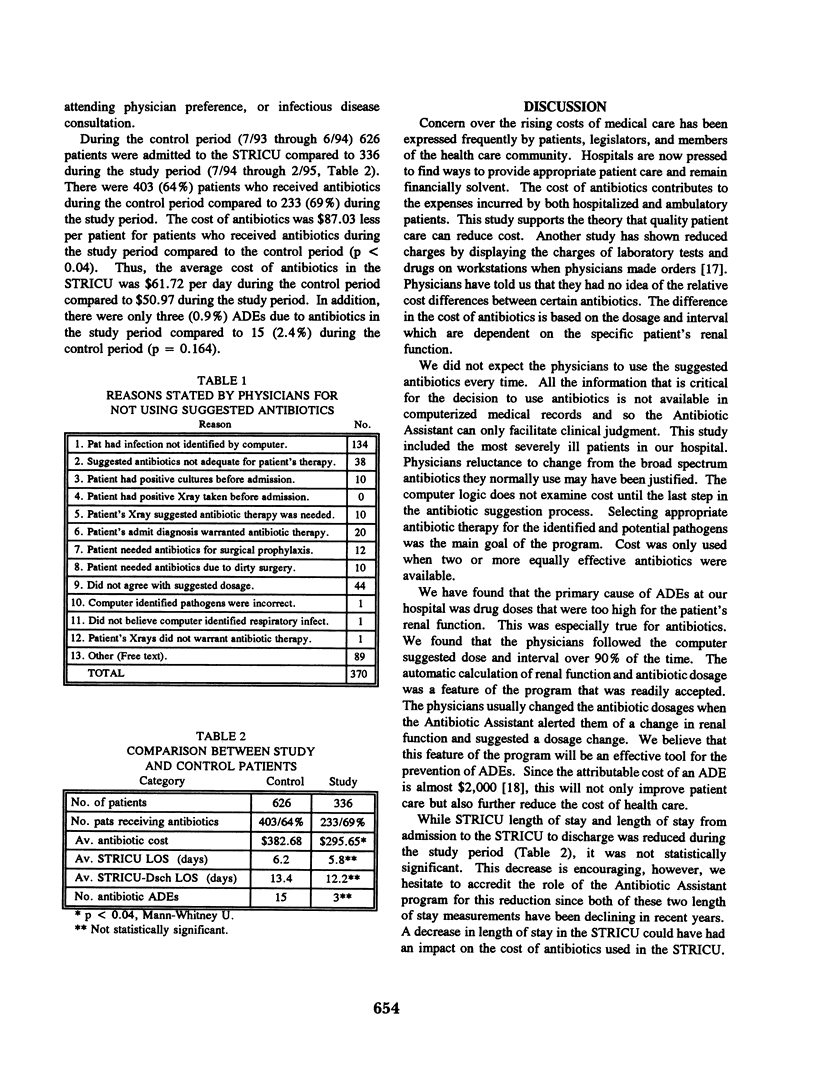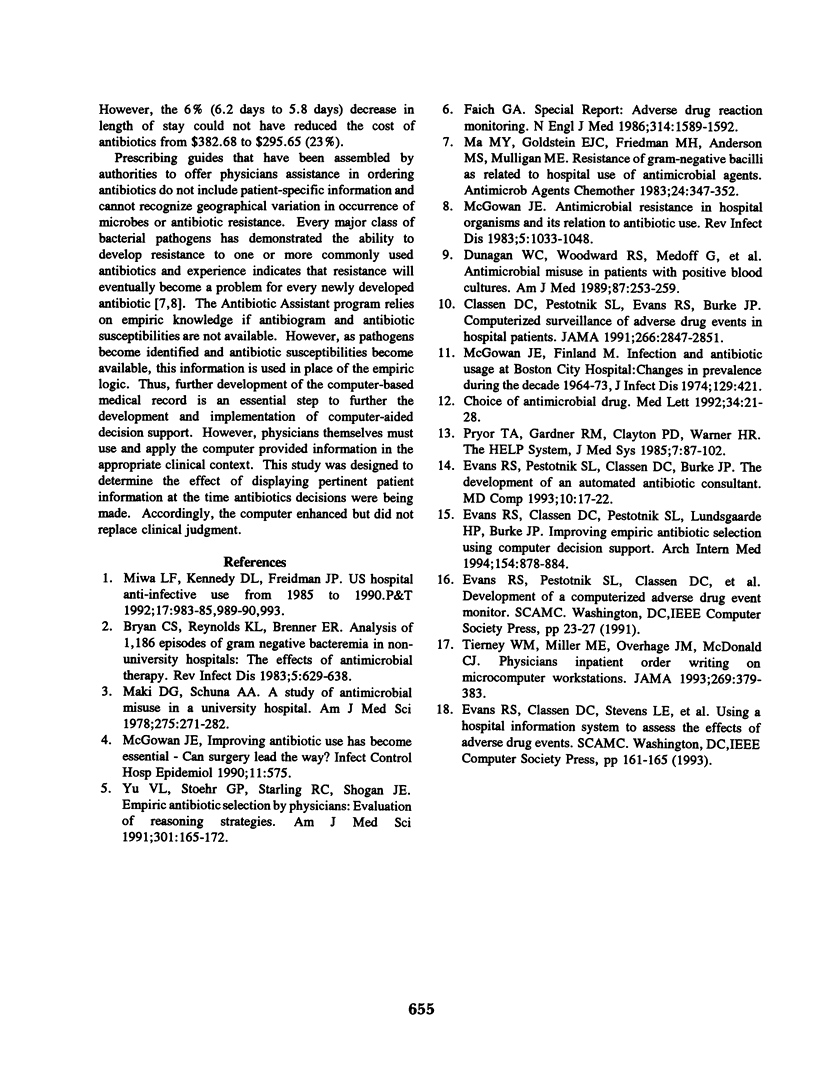Abstract
We developed a decision support tool to assist physicians anticipating the need for antibiotic therapy. The initial screen alerts physicians of pertinent patient information, provides direct access to other essential medical information, and stimulates clinical judgment by suggesting an antibiotic regimen. The decision support tool also suggests the dose and interval for any ordered antibiotics selected by the physicians. During a 7-month pilot study, all antibiotics for patients admitted to the Shock/Trauma/Respiratory Intensive Care Unit (STRICU) were ordered using the decision support tool. Clinical data from the study period and a 12-month control period (the previous year) were collected and compared. The decision support tool was used to order antibiotics 588 times during the study period and the suggested antibiotics were used 218 (37%) times. The computer suggested dosages were used over 90% of the time. The mean cost of antibiotics was $87.00 (p < 0.04) less per patient during the study period as compared to the control period. Prospective assessment revealed only 3 antibiotic adverse drug events (ADEs) (0.9%) among 336 study patients as compared to 15 ADEs (2.4%) among 626 control patients (p = 0.164).
Full text
PDF




Selected References
These references are in PubMed. This may not be the complete list of references from this article.
- Bryan C. S., Reynolds K. L., Brenner E. R. Analysis of 1,186 episodes of gram-negative bacteremia in non-university hospitals: the effects of antimicrobial therapy. Rev Infect Dis. 1983 Jul-Aug;5(4):629–638. doi: 10.1093/clinids/5.4.629. [DOI] [PubMed] [Google Scholar]
- Classen D. C., Pestotnik S. L., Evans R. S., Burke J. P. Computerized surveillance of adverse drug events in hospital patients. JAMA. 1991 Nov 27;266(20):2847–2851. [PubMed] [Google Scholar]
- Dunagan W. C., Woodward R. S., Medoff G., Gray J. L., 3rd, Casabar E., Smith M. D., Lawrenz C. A., Spitznagel E. Antimicrobial misuse in patients with positive blood cultures. Am J Med. 1989 Sep;87(3):253–259. doi: 10.1016/s0002-9343(89)80146-9. [DOI] [PubMed] [Google Scholar]
- Evans R. S., Classen D. C., Pestotnik S. L., Lundsgaarde H. P., Burke J. P. Improving empiric antibiotic selection using computer decision support. Arch Intern Med. 1994 Apr 25;154(8):878–884. [PubMed] [Google Scholar]
- Evans R. S., Pestotnik S. L., Classen D. C., Burke J. P. Development of an automated antibiotic consultant. MD Comput. 1993 Jan-Feb;10(1):17–22. [PubMed] [Google Scholar]
- Faich G. A. Adverse-drug-reaction monitoring. N Engl J Med. 1986 Jun 12;314(24):1589–1592. doi: 10.1056/NEJM198606123142427. [DOI] [PubMed] [Google Scholar]
- Ma M. Y., Goldstein E. J., Friedman M. H., Anderson M. S., Mulligan M. E. Resistance of gram-negative bacilli as related to hospital use of antimicrobial agents. Antimicrob Agents Chemother. 1983 Sep;24(3):347–352. doi: 10.1128/aac.24.3.347. [DOI] [PMC free article] [PubMed] [Google Scholar]
- Maki D. G., Schuna A. A. A study of antimicrobial misuse in a university hospital. Am J Med Sci. 1978 May-Jun;275(3):271–282. doi: 10.1097/00000441-197805000-00005. [DOI] [PubMed] [Google Scholar]
- McGowan J. E., Jr Antimicrobial resistance in hospital organisms and its relation to antibiotic use. Rev Infect Dis. 1983 Nov-Dec;5(6):1033–1048. doi: 10.1093/clinids/5.6.1033. [DOI] [PubMed] [Google Scholar]
- McGowan J. E., Jr, Finland M. Infection and antibiotic usage at Boston City Hospital: changes in prevalence during the decade 1964-1973. J Infect Dis. 1974 Apr;129(4):421–428. doi: 10.1093/infdis/129.4.421. [DOI] [PubMed] [Google Scholar]
- McGowan J. E., Jr Improving antibiotic use has become essential--can surgery lead the way? Infect Control Hosp Epidemiol. 1990 Nov;11(11):575–577. doi: 10.1086/646097. [DOI] [PubMed] [Google Scholar]
- Pryor T. A., Gardner R. M., Clayton P. D., Warner H. R. The HELP system. J Med Syst. 1983 Apr;7(2):87–102. doi: 10.1007/BF00995116. [DOI] [PubMed] [Google Scholar]
- Tierney W. M., Miller M. E., Overhage J. M., McDonald C. J. Physician inpatient order writing on microcomputer workstations. Effects on resource utilization. JAMA. 1993 Jan 20;269(3):379–383. [PubMed] [Google Scholar]
- Yu V. L., Stoehr G. P., Starling R. C., Shogan J. E. Empiric antibiotic selection by physicians: evaluation of reasoning strategies. Am J Med Sci. 1991 Mar;301(3):165–172. doi: 10.1097/00000441-199103000-00003. [DOI] [PubMed] [Google Scholar]


